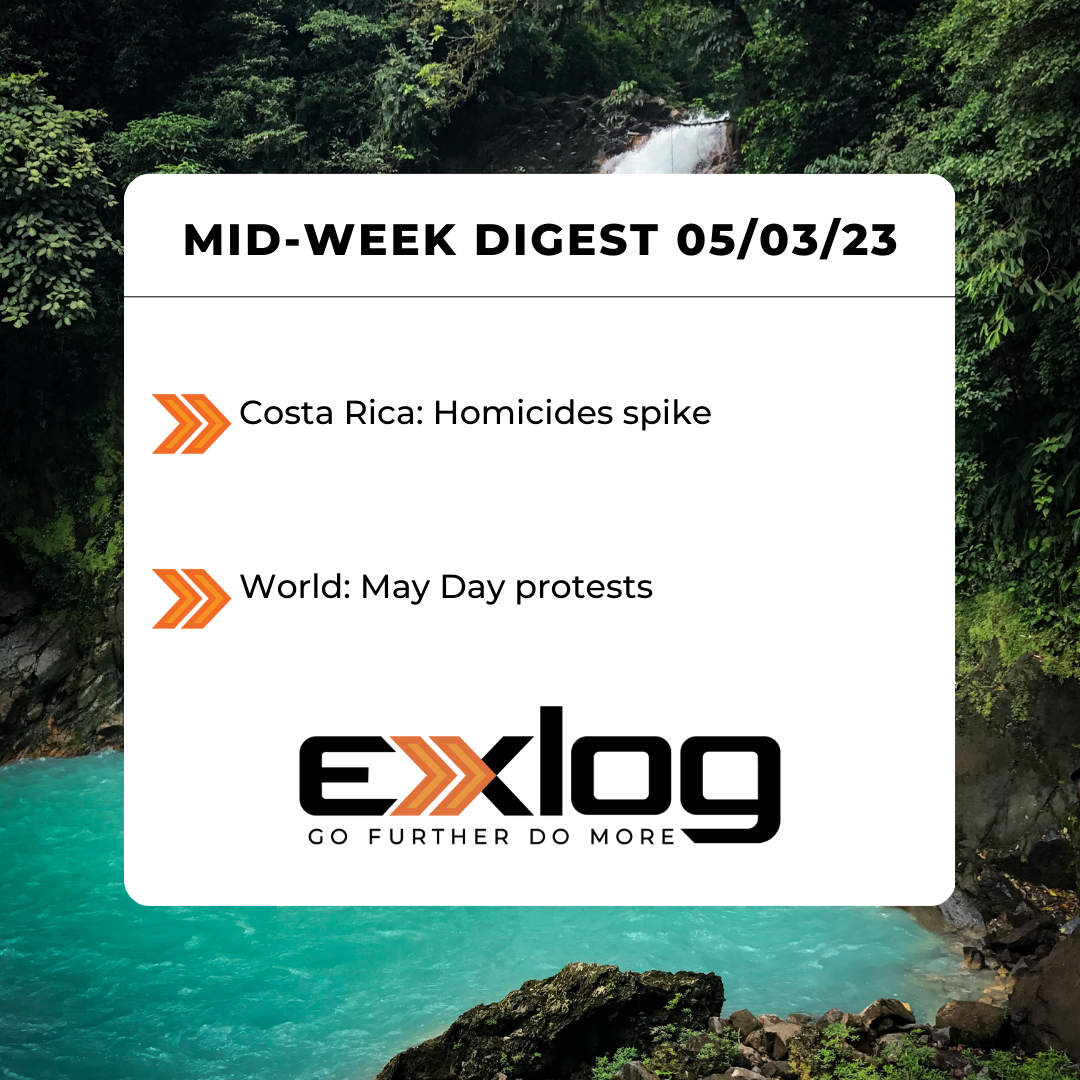Homicides spike in Costa Rica and worldwide May Day Protests
Costa Rica: Record-high crime figures prompt crackdown on gangs
Recent figures released by Costa Rican law enforcement indicate a rising threat of gang-related crime, including homicide, particularly in areas of San José and Limón provinces. Statistics provided by the country’s Judicial Investigation Agency (OIJ) report 211 homicides nationwide between January and March 2023 – an increase of 10% over the previous quarter and 35% over the same period in 2022. This follows figures released in January showing that 2022 was the most violent year on record in Costa Rica, with 655 total homicides and a national rate of 12.6 per 100,000 residents. Authorities have attributed the rise in crime to increased competition between gangs over lucrative drug trafficking routes and infrastructure, pointing to victimization figures as well as the geographic distribution of recorded homicides. Official reports since January 2022 indicate that roughly two-thirds of homicides nationwide are motivated by “score-settling,” nearly three-quarters involve firearms, and that most victims are young Costa Rican men with criminal records or links to known criminal organizations. The rising homicide tally in the canton of Limón – located on the Caribbean coast and housing a major container port which is a crucial cocaine transshipment point – in the first months of 2023 serves as further evidence of increased gang activity. OIJ figures show that homicides in the area surged to an annualized rate of 83.8 per 100,000 residents compared to a rate of 62.9 per 100,000 in 2022. The only canton with more total homicides between January and March 2023 was the capital, San José; the canton reported 24 homicides for an annualized rate of 27.3 per 100,000, up from 14.2 the previous year. In response to rising insecurity, Costa Rican authorities launched a six-month security operation in mid-April. Local media report that police detained more than 2,600 people and seized dozens of firearms during the first week of the operation. Costa Rica has also secured USD 14 million worth of security equipment from the US government in an effort to combat “international criminal gangs.” In addition to these policing initiatives, the Costa Rican government is considering legislative reforms that would toughen various criminal penalties. While these initiatives may help suppress or deter domestic organized crime in the near term, a permanent reversal of rising gang-related insecurity is unlikely given the international nature of criminal enterprise in Costa Rica. Furthermore, a security crackdown that successfully eliminates the established leadership of organized crime groups risks fracturing the criminal landscape in Costa Rica and exacerbating inter- and intra-gang conflict over the long term.
World: Unresolved labor issues trigger May Day rallies
Labor organizers and other activists worldwide joined numerous rallies on May 1 to mark International Workers’ Day – known as “May Day.” While most proceeded peacefully, episodes of violence were reported amid some demonstrations linked to ongoing protest movements. In Italy, anti-government protesters joined workers to demonstrate against government measures approved on May 1 that would boost employment and pay rates by cutting aid to the poor. Tens of thousands attended various rallies in South Korea, with 30,000 people attending the two main demonstrations in Seoul. Spain’s unions organized more than 70 marches, warning of “social conflict” if salaries did not rise in line with inflation. Approximately 300,000 Germans defied recent calls to restrict the right to strike by participating in almost 400 total protests organized by labor unions and leftist groups in major cities including Berlin, Kreuzberg, and Cologne. May Day demonstrations turned violent in France, where approximately 800,000 people participated in more than 300 union-organized protests across the country as police responded with riot control measures. Protestors set fire to cars and bicycles and threw Molotov cocktails at security forces, resulting in the arrest of 540 people and injuring 406 police and gendarmes. While the US celebrates its Labor Day in September, peaceful workers’ rights rallies materialized in major cities including Seattle, Los Angeles, and San Francisco. Other countries holding peaceful demonstrations included Turkey, Japan, Indonesia, and Taiwan. This year’s May Day rallies witnessed larger turnouts than in previous years, likely due to both drastically loosened COVID-19 restrictions and ongoing protest movements in many countries. While calls for higher salaries, reduced working hours, and better working conditions remained at the center of this year’s demonstrations, rising inflation has contributed to high turnout and expressions of anger at European rallies. Many May Day rallies were organized as a continuation of ongoing labor action – most notably, this year’s German transportation strikes for higher wages and violent French protests against controversial pension reforms. While the majority of the rallies remained peaceful and confined to May 1, disruptive labor strikes in Europe and violent protests in France are likely to persist until governments can effectively address inflation and satisfy urgent labor demands.


